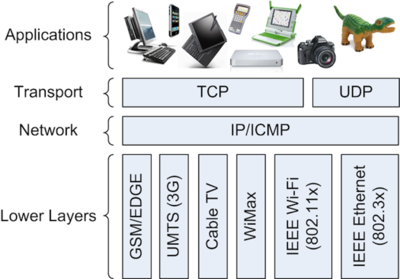Difference between revisions of "Network Protocol"
| Line 8: | Line 8: | ||
*[[The Institute of Electrical and Electronics Engineers (IEEE)]] | *[[The Institute of Electrical and Electronics Engineers (IEEE)]] | ||
A protocol suite is a set of different network protocols that cooperate to exchange information and enable internet connectivity across various layers. For example: the [[TCP/IP (Transmission Control Protocol/Internet Protocol)|TCP/IP]] suite comprehends the [[Transmission Control Protocol (TCP)]], [[User Datagram Protocol (UDP)]], [[Internet Protocol (IP)]], and [[Hypertext Transfer Protocol (HTTP)]] or [[File Transfer Protocol (FTP)]]. Each one of them allow the transmission of data between devices at the information packet level (mainly TCP, and UDP as well to add an additional layer of stability), Internet address level (IP), and display level (HTTP and FTP).<ref>Explaining Network Protocols [https://www.techopedia.com/definition/12938/network-protocols Techopedia]</ref> | A protocol suite is a set of different network protocols that cooperate to exchange information and enable internet connectivity across various layers. For example: the [[TCP/IP (Transmission Control Protocol/Internet Protocol)|TCP/IP]] suite comprehends the [[Transmission Control Protocol (TCP)]], [[User Datagram Protocol (UDP)]], [[Internet Protocol (IP)]], and [[Hypertext Transfer Protocol (HTTP)]] or [[File Transfer Protocol (FTP)]]. Each one of them allow the transmission of data between devices at the information packet level (mainly TCP, and UDP as well to add an additional layer of stability), Internet address level (IP), and display level (HTTP and FTP).<ref>Explaining Network Protocols [https://www.techopedia.com/definition/12938/network-protocols Techopedia]</ref> | ||
| + | |||
| + | |||
| + | '''The Typical Structure of a Network Protocol<ref>The Typical Structure of a Network Protocol [https://thecustomizewindows.com/2013/06/what-is-network-protocol/ Abhishek Ghosh]</ref>'''<br /> | ||
| + | The structure described in any one of a protocol data packet includes the important information about data exchange package, such as: | ||
| + | *The sender and receiver | ||
| + | *The type of the packet (e.g. connect , disconnect or pure data) | ||
| + | *The packet length | ||
| + | *A checksum | ||
| + | |||
| + | |||
| + | [[File:Network Protocol.png|400px|Network Protocol]]<br /> | ||
| + | Source: | ||
| + | |||
| + | |||
| + | This information is provided as a header to the payload data or attached as a preview. Moreover, in some protocols; fixed packet sequences for the connection establishment and release are described. These actions cause further traffic on the data lines – the so-called overhead. This overhead is undesirable because it burdens the capacity, but due to the more important tasks, making the logs, usually it is used. With User Datagram Protocol (UDP), in the transport layer a minimal overhead is available that does not ensure end-to-end control of the transmission. In contrast, in the Transmission Control Protocol (TCP), the checksum for the test to verify the data packet is complete. If the checksum does not meet expectations of the test algorithm, the data packet is discarded and requested again at the sending site. | ||
Revision as of 18:57, 30 June 2021
A network protocol contains a set of rules that determine how to transmit and receive data between devices in the same network. Standardized network protocols are important for providing a common language so that the network devices can successfully send and receive information. Rules of network protocol include guidelines that regulate the following characteristics of a network: access method, allowed physical topologies, types of cabling, and speed of data transfer. One of the most popular models that are used to build open communication between two network systems is the Open Systems Interconnection (OSI) model.[1]
Network protocols incorporate all the processes, requirements and constraints of initiating and accomplishing communication between computers, servers, routers and other network-enabled devices. They must be confirmed and installed by the sender and receiver to ensure network/data communication and apply to software and hardware nodes that communicate on a network. Network protocols are developed and published by several groups according to certain industry standards. The most important ones include:
- World Wide Web Consortium (W3C)
- International Telecommunication Union (ITU)
- International Organization for Standardization (ISO)
- Internet Engineering Task Force (IETF)
- The Institute of Electrical and Electronics Engineers (IEEE)
A protocol suite is a set of different network protocols that cooperate to exchange information and enable internet connectivity across various layers. For example: the TCP/IP suite comprehends the Transmission Control Protocol (TCP), User Datagram Protocol (UDP), Internet Protocol (IP), and Hypertext Transfer Protocol (HTTP) or File Transfer Protocol (FTP). Each one of them allow the transmission of data between devices at the information packet level (mainly TCP, and UDP as well to add an additional layer of stability), Internet address level (IP), and display level (HTTP and FTP).[2]
The Typical Structure of a Network Protocol[3]
The structure described in any one of a protocol data packet includes the important information about data exchange package, such as:
- The sender and receiver
- The type of the packet (e.g. connect , disconnect or pure data)
- The packet length
- A checksum
This information is provided as a header to the payload data or attached as a preview. Moreover, in some protocols; fixed packet sequences for the connection establishment and release are described. These actions cause further traffic on the data lines – the so-called overhead. This overhead is undesirable because it burdens the capacity, but due to the more important tasks, making the logs, usually it is used. With User Datagram Protocol (UDP), in the transport layer a minimal overhead is available that does not ensure end-to-end control of the transmission. In contrast, in the Transmission Control Protocol (TCP), the checksum for the test to verify the data packet is complete. If the checksum does not meet expectations of the test algorithm, the data packet is discarded and requested again at the sending site.
- ↑ Definition - What Does Network Protocol Mean? Wondershare
- ↑ Explaining Network Protocols Techopedia
- ↑ The Typical Structure of a Network Protocol Abhishek Ghosh

